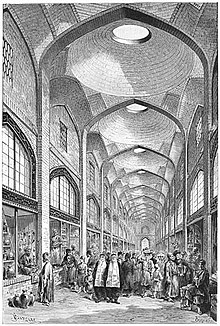History of Shiraz
The city of Shiraz, Iran is more than 4000 years old.
Pre-Islamic times
Shiraz is founded in
There is mention of a city at Shiraz during the
Islamic period
The city became a provincial capital in 693, after the Arabs conquered
The city was spared destruction by the invading

As early as the 11th century, several hundred thousand people inhabited Shiraz.[5] In the 14th century Shiraz had sixty thousand inhabitants.[6] During the 16th century it had a population of 200,000 people, which by the mid-18th century had decreased to only 50,000.
In 1504 Shiraz was captured by the forces of
Shiraz soon returned to prosperity under the enlightened rule of

Shiraz is the birthplace of the founder of the short-lived Babi movement, the Báb (Sayyid `Ali-Muhammad Shirazi, 1819-1850). In this city, on the evening of 22 May 1844, he began discussions that led to his claiming to be an interpreter of the Qur'an, the first of several progressive claims between then and 1849. Since the Báb is considered a 'forerunner' of the Baháʼí Faith, Shiraz is a holy city for Bahá’ís, where the Báb's House (demolished in 1979 by the Islamic regime) was a putative pilgrimage site.
In 1910 a
The city's role in trade greatly diminished with the opening of the trans-Iranian railway in the 1930s, as trade routes shifted to the ports in Khuzestan. Much of the architectural inheritance of Shiraz, and especially the royal district of the Zands, was either neglected or destroyed as a result of irresponsible town planning under the Pahlavi dynasty. Lacking any great industrial, religious or strategic importance, Shiraz became an administrative centre, although its population has grown considerably since the 1979 revolution.[9]
Recent history
Recently many historical sites in the city were renovated. But in 1979, the Islamic regime demolished the beautifully restored house that had belonged to Sayyid 'Ali Muhammad Shirazi, the Bab, and built a mosque on the site. The Shiraz International Airport is expanded.
Agriculture has always been a major part of the economy in and around Shiraz. This is partially due to a relative abundance of water compared to the surrounding deserts. The Gardens of Shiraz and "Evenings of Shiraz" are famous throughout Iran and the middle east. The moderate climate and the beauty of the city has made it a major tourist attraction.
Shiraz is also home to many
The municipality of Shiraz and the related cultural institutions have promoted and carried out many important restoration and reconstruction projects through the city.
Timeline
References
- ^ Cameron, George G. This is wrongTreasury Tablets, University of Chicago Press, 1948, pp. 115.
- ^ "Fárs and Shíráz"[permanent dead link]
- ^ a b c d e f g h i j "History of Shiraz". Retrieved 2008-01-31.
- ^ (pdf file)
- ^ "Shiraz, Iran" Archived 2007-12-26 at the Wayback Machine
- ^ (Google book search)
- ^ Littman (1979), p. 14
- ^ Littman (1979), p. 12
- ^ Shiraz History - Shiraz Travel Guide - Lonely Planet
